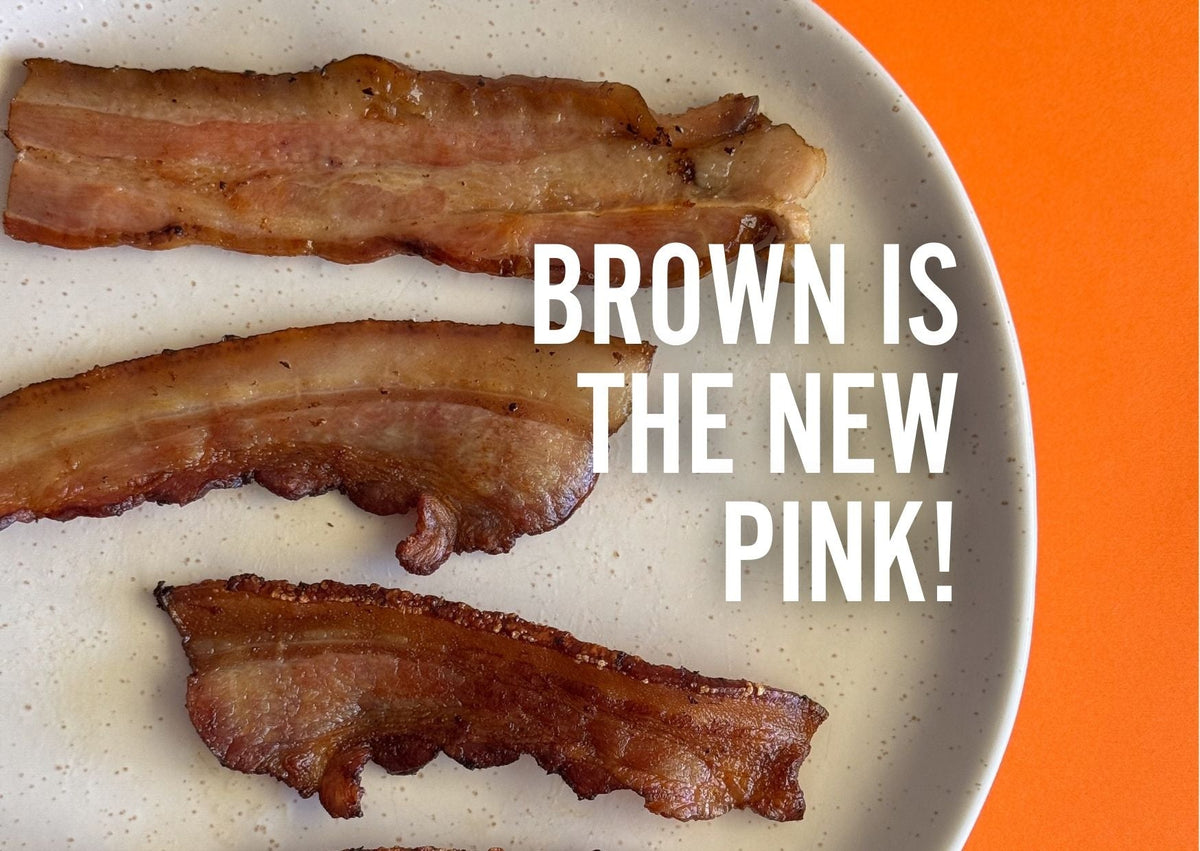
Why Nitrate Free Bacon is Brown – And Why That’s a Good Thing
|
Time to read 3 min
|
Time to read 3 min
If you’ve ever picked up a pack of our nitrate free bacon, opened it, and thought: “Wait... why is this brown?”
You’re not alone.
Most of us have grown up thinking bacon should be bright pink and super glossy. But here’s the truth: real, healthy bacon doesn’t look like that. And that brown colour? It’s actually a very good sign.
Let’s break down why nitrate free bacon looks different, why pasture raised pork makes all the difference, and how you can make better choices when it comes to healthy meat in Australia.
To really appreciate your brown bacon, let’s quickly look at how the other kind is made.
Mass-produced bacon usually involves:
Industrial pork (often from pigs raised in pens)
A chemical brine of salt, sugar, and synthetic nitrates
Injecting or soaking the meat in this solution
Smoking or steaming in controlled environments
While this process is efficient and creates long shelf life, it’s far from natural. And if you’re after healthy meat in Australia, this probably isn’t it.
💡 Pro tip: Don't be put off by the brown colour. That’s the good stuff.
Conventional bacon (the kind you see stacked in supermarket fridges) is usually made with sodium nitrate or sodium nitrite. These chemical compounds help preserve the meat, give it that pink hue, and keep bacteria like Clostridium botulinum at bay. Basically, the nitrates act like bacon’s built-in insurance policy, making it shelf stable and photogenic.
But here’s the catch: when nitrites are exposed to high heat (like when you fry bacon), they can form nitrosamines - chemicals that have been linked to cancer risks by health organisations like the World Health Organization (WHO).
That’s why more Aussies are switching to nitrate free bacon as part of a cleaner, more natural diet.
🔗 Source: WHO, International Agency for Research on Cancer – Processed Meat & Cancer Risk (2015)
Here’s the deal: when you remove nitrates and nitrites, bacon no longer stays pink.
Instead, the meat takes on a more natural, brownish colour, a result of traditional curing methods, oxidation, and the meat simply being real. It’s how bacon used to look before commercial processing took over.
So no, your brown bacon isn’t off. In fact, it likely means:
It hasn’t been artificially coloured or preserved
It was cured without nitrates
You've scored it from someone like us who values quality over shelf life
Going nitrate free isn’t just about colour — it’s about cutting out synthetic additives and eating food that’s closer to its natural state. Here are a few benefits:
✅ Fewer chemical preservatives
✅ Lower risk of nitrosamines
✅ Often kinder on sensitive stomachs
✅ A better fit for a whole foods, healthy meat diet in Australia
And let’s not forget the taste — many food lovers claim nitrate free bacon has a deeper, richer, more authentic pork flavour.
Let’s talk about the pork behind the bacon.
The best nitrate free, high quality bacon is made from pasture raised pork and that’s not a coincidence. Pigs raised on pasture (not in crowded feedlots) have:
More space to roam and forage naturally
Better diets (no grain overload, antibiotics or growth hormones)
Less stress, which means more tender meat
Aussie farms producing pasture raised pork tend to focus on sustainability, animal welfare, and superior flavour — making it a win for your plate and the planet.
Choosing nitrate free bacon is more than a health move — it’s about getting back to real food. Sure, it might look a little rustic, but it’s exactly what bacon should look like when it’s made with care, quality pork, and without unnecessary chemicals.
So next time someone says your bacon looks “a bit brown,” just smile — and tell them it's the colour of honesty on a plate.
Nitrate free bacon is brown because it lacks synthetic preservatives like sodium nitrite, which keep conventional bacon pink
The brown colour is natural and safe, resulting from traditional curing and oxidation
Nitrates and nitrites, when cooked at high temperatures, can form harmful compounds (nitrosamines).Choosing nitrate free bacon reduces exposure to potentially carcinogenic additives
Brown bacon means you're eating real, healthy meat — not a chemically altered version
Pastured Eggs are the New Free Range [SBS, 2016]
Are your eggs really free-range? [Choice, 2021]
Model Code of Practice for the Welfare of Animals: Domestic Poultry [CSIRO, 2002]


